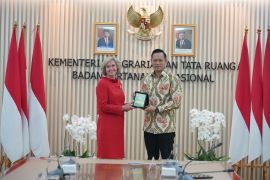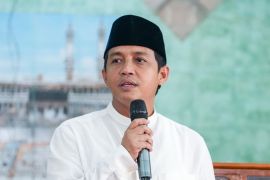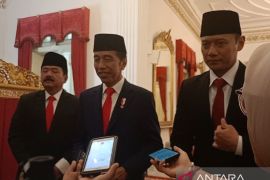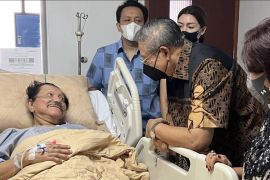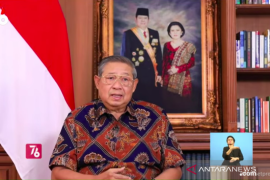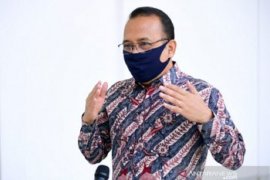The government`s commitment to improve the TNI`s armament system was expressed by President Susilo Bambang Yudhoyono in his state address delivered on August 16 before members of the House of Representatives (DPR), the People`s Consultative Assembly (MPR), and Regional Representatives Council (DPD).
"As the state`s financial capability keeps growing, we are also determined to continue modernizing the primary equipment of our defense forces," said the president.
To meet the military`s minimum armament needs for optimizing the TNI`s ability to protect the country, President Yudhoyono had chaired several limited cabinet meetings discussing procurement of main armament system (Alutsista) hardware.
At the last meeting on Monday (Sept 19), they discussed a plan to procure Alutsista by using foreign loans from 2010 to 2014.
President Yudhoyono at a previous meeting (Sept 8) pointed out that priority should be given to domestic manufacturers in the procurement of Alutsista hardware for the Indonesian military (TNI) and Police.
Alutsista hardware could be purchased from other countries only if domestic manufacturers were still unable the produce the armaments concerned.
"If no company at home , including PT PAL, Pindad, DI , LEN and others has full capacity to produce the needed equipment, efforts should be made to establish cooperation like joint production, joint investment with similar manufacturers of other countries," he said.
He also reminded that because the procurement of Alutsista was very costly, so the hardware should be obtained from the domestic budget to reduce Indonesia`s relying on foreign loans.
"The procurement of Alutsista using loans especially foreign loans must be avoided. We need to begin using more of our own budget," he said.
The President also underlined the importance of transparency and accountability in the procurement of alutsista, so that every rupiah spent can be accounted for.
Defense Minister Purnomo Yusgiantoro after the Sept 19 limited cabinet meeting, revealed that the government will allocate Rp99 trillion for the maintenance and purchase of main armament systems until 2014.
"This is a national program which is directly coordinated by the President," he said.
The fourth meeting on Alutsista procurement also discussed the final draft list of armaments which became the government`s priority to buy or produce them soon.
Submarines and patrol ships for the Navy, assault and combat helicopters and transport helicopters for the Army were among the armaments that were high on the list of the government`s priorities were he said.
The funding sources to finance the maintenance and purchase of Alutsista could be the state budget, domestic loans or foreign loans which would be determined by the government soon.
The government has set up a high-level committee to manage and supervise the procurement and strengthening of the main armament systems.
"The high-level committee is led by Deputy Defense Minister Sjafrie Sjamsoeddin while its members come from the Defense Ministry, the Finance Ministry, Bappenas (National Development Planning Agency), BPKP (Finance and Development Comptroller), LKPP (Government Procurement Regulatory Body) and several internal auditing units at relevant ministries," the minister said.
National Development Planning Minister Armida Alisjahbana who is also Bappenas chief said the budget fund consisted of Rp32.5 trillion for the maintenance of main armament systems and Rp66.5 trillion for capital expenditure.
Indonesia`s defense system is still facing problems related to the provision of arms and the maintenance of arsenals due to budget constraint.The problem has caused concern regarding the TNI`s capability to protect the country.
"The problems exist due to the government`s limited budget and lack of political will to develop our own strategic industries," Fayakhun Andriadi, a member of the House of Representatives` Commission I, said in June 2011.
In terms of budget, he said, there was a gap between the budget demanded for the weaponry system and the realization from the government.
"Sometimes the gap can reach up to 400 percent. For example, the Ministry of Defense in 2008 and 2009 proposed to have a budget of Rp100.5 billion and Rp127.1 billion respectively. However, the central government could only approve Rp32.8 billion for 2008 and Rp33.6 billion for 2009. In 2010, the proposed budget was Rp158.1 billion but the amount realization was only Rp40.6 billion," he said.
Defense Minister Purnomo last July 2011 said the government was committed to reforming and modernizing the Indonesian Defense Forces (TNI)`s weaponry system in accordance with the trends in the development of potential threats.
The government has produced a blueprint on the modernization of the TNI`s weaponry system, to meet the minimum essential forces` need (MEF) which would be carried out in stages up to 2024.
To meet the MEF needs, three steps have been set, namely giving priority to domestic products for weapons, to cooperate or conclude agreements with other countries on joint production schemes and at the same time effect transfer of technology , and to wait until the national arms industry is capable of meeting the TNI`s need for main weapons.
Deputy Defense Minister Sjafrie Sjamsoeddin recently stated that Indonesia was to increasingly rely on domestic sources for military hardware and preparing the required law for realizing the plan.
The government had started to carry out the plan five years ago by taking the initiative to produce Anoa armored personnel carriers using domestic know-how in making the vehicle`s entire body, except the engine.
The country would soon also retrofit some 400 tanks and refurbish them with new technologies and equipment, Sjafrie said. The effort would be a precursor to full-pledged national production of tanks.
State-owned shipbuilder PT PAL last March 2011 handed over a warship, the KRI Banda Aceh, to the defense ministry to support the Indonesian navy`s operations.
"All the targets set in the contract have been met. Some of the ship`s capabilities have even surpassed the targets such as the ship`s speed set in the contract at 15 knots but in tests the ship could reach speeds of up to 15.2 knots. This proves that domestically produced ships can be relied upon and are things we can pride ourselves in," Harsusanto, the company`s president director, said.
Since 1980 PT PAL has already built more than 200 ships of various kinds and sizes including merchant vessels with displaxements of up to 50,000 DWT while it has also been able to build warships ordered by the navy.
PT PAL had also been able to produce various kinds and versions of [atrol speed boats varying in length between 14 and 57 meters.
KRI Banda Aceh was the fourth warship of LDP version produced by PT PAL. The company has partnered with Daewoo International Corporation for building the ship.
In April 2011, Defense Minister Purnomo launched the "KRI Clurit", a 40-meter-long ship made in Indonesia to be used to help secure the country`s waters in the western region.
The KRI Clurit was a swift missile-carrying ship designed and built fully by Indonesians at PT Palindo Marine in Batam, Riau Islands Province.
"With it, Indonesia has started to have the capability to safeguard its seas with self-made ships. We no longer need handouts. This event is a milestone in the country`s journey to defense industry self-reliance," he said.
He said production of main defense equipment would not stop with the KRI Clurit`s making. He said the government would continue to provide TNI with more ships. He said a submarine and a destroyer made in Indonesia would be the next additions to the Indonesian navy`s fleet.(*)
HAJM/F001
Reporter: Fardah
Editor: Jafar M Sidik
Copyright © ANTARA 2011
